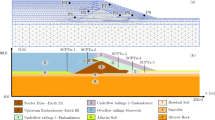Abstract
The analysis of stability of slopes is a classical problem for geotechnical engineers. In practice, many methods are available for the desired purpose, from basic kinematic analysis to two- and three-dimensional limit equilibrium analyses and numerical modeling with various user-friendly softwares. However, additional techniques are also required to provide knowledge necessary for decision-making. In this research, a reliable dataset provided by Sah et al. (1994) was used to analyze the stability evaluation of rock slopes subjected to circular failures. For this purpose, using Slide 2018 program, 44 separate limit equilibrium slope models were built for each case given in the original work. The provided material properties and slope geometries in heavily fractured and/or very weak or highly weathered rock masses were considered during the model building stage. It was found that Slide 2018 program generated dissimilar safety factors compared to those given by Sah et al. (1994) for the investigated slope cases. Binary logistic and multiple linear regression techniques were implemented in the study to promote alternative approaches for the prediction of the stability condition and safety factor (SF) of slopes excavated in heavily fractured/highly weathered rock masses. The condition of slopes (stable or failed) was predicted by binary logistic regression model with 90.9% accuracy. The SF of the slopes was estimated by a multiple linear regression model with 95.6% accuracy. It was concluded that both statistical techniques could be sufficiently used as alternative approaches to predict the stability condition and SF of rock slopes prone to circular (rotational) failures.









Similar content being viewed by others
References
Agliardi F, Crosta GB, Meloni F, Valle C, Rivolta C (2013) Structurally-controlled instability, damage and slope failure in a porphyry rock mass. Tectonophysics 605:34–47
Akdag S, Basarir H, Karpuz C, Ozyurt M (2015) Stability analysis and optimized slope angle for the iron ore open-pit mine. In: 24th International Mining Congress and Exhibition of Turkey, Chamber of Mining Engineers of Turkey
Akram MS, Ahmed L, Farooq S, Ahad MA, Muzammil S, Zaidi H, Khan M, Azhar MU (2018) Geotechnical evaluation of rock cut slopes using basic rock mass rating (RMR basic), slope mass rating (SMR) and kinematic analysis along Islamabad Muzaffarabad dual carriageway (IMDC), Pakistan. J Biodv Envirn Sci 13(1):297–306
Baghbanan A, Kefayati S, Torkan M, Hashemolhosseini H, Dehnavi RN (2017) Numerical probabilistic analysis for slope stability in fractured rock masses using DFN-DEM approach. Int J Min Geo-Engng 51(1):79–90
Bishop AW (1955) The use of the slip circle in the stability analysis of slopes. Geotechnique 5(1):7–17
Draper NR, Smith H (1981) Applied regression analysis. Wiley, New York
Gurocak Z, Alemdag S, Zaman MM (2008) Rock slope stability and excavatability assessment of rocks at the Kapikaya dam site, Turkey. Engng Geol 96(1–2):17–27
Harnett DL, Horrell JF (1998) Data, statistics, and decision models with excel. Wiley, New York
Hosmer DW, Lemeshow S (2000) Applied logistic regression. Wiley, New York
Janbu N (1968) Slope stability computations. Soil Mech. and Found. Engng. Rep., The Technical University of Norway, Trondheim, Norway
Kentli B, Topal T (2004) Assessment of rock slope stability for a segment of the Ankara–Pozantı motorway, Turkey. Eng Geol 74(1–2):73–90
Kleinbaum DG, Klein M (2002) Logistic regression: a self learning text. Springer, New York
Kundu J, Sarkar K, Singh TN (2017) Static and dynamic analysis of rock slope - a case study. Procedia Engng 191:744–749
Leech NL, Barrett KC, Morgan GA (2005) SPSS for intermediate statistics: use and interpretation. Lawrence Erlbaum, New Jersey
Li AJ, Merifield RS, Lyamin AV (2011) Effect of rock mass disturbance on the stability of rock slopes using the Hoek–Brown failure criterion. Comput Geotech 38(4):546–558. https://doi.org/10.1016/j.compgeo.2011.03.003
Mohtarami E, Jafari A, Amini M (2014) Stability analysis of slopes against combined circular–toppling failure. Int J Rock Mech Min Sci 67:43–56
Nandi A, Shakoor A (2008) Application of logistic regression model for slope instability prediction in Cuyahoga River watershed, Ohio, USA. Georisk: Assessment and Management of Risk for Engineered Systems and Geohazards 2(1):16–27
Patnayak S, Reddy KN, Gupta RN (2002) Slope stability analysis of a lead-zinc open pit mine using limit equilibrium and numerical methods. Int J Surf Min Reclam Environ 16(3):196–216
Rocscience (2018a) Slide 2018 v9.0 User’s Guide. Rocscience Inc, Toronto
Rocscience (2018b) RS2 v9.0 User’s Guide. Rocscience Inc, Toronto
Sah NK, Sheorey PR, Upadhyaya LN (1994) Maximum likelihood estimation of slope stability. Int J Rock Mech Min Sci Geomech Abst 31(1):47–53
Sari M (2019) Stability analysis of cut slopes using empirical, kinematical, numerical and limit equilibrium methods: case of old Jeddah–Mecca road (Saudi Arabia). Environmental Earth Sciences 78(21)
Scott M (2002) Applied logistic regression analysis. In: Quantitative applications in the social sciences, vol 106. Sage Publications, Thousand Oaks
Siddque T, Pradhan SP (2018) Stability and sensitivity analysis of Himalayan road cut debris slopes: an investigation along NH-58, India. Nat Hazards 93(2):577–600
Spencer E (1967) A method of analysis of the stability of embankments assuming parallel inter-slice forces. Geotechnique 17(1):11–26
SPSS v.16.0 (2007) Statistical analysis software (standard version). SPSS, New York
Tahari A, Tani K (2010) Assessment of the stability of rock slopes by the slope stability rating classification system. Rock Mech Rock Enginng 43(3):321–333
Tutluoglu L, Öge IF, Karpuz C (2011) Two and three dimensional analysis of a slope failure in a lignite mine. Comput Geosci 37(2):232–240
Author information
Authors and Affiliations
Corresponding author
Additional information
Responsible Editor: Amjad Kallel
This paper was selected from the 1st Conference of the Arabian Journal of Geosciences (CAJG), Tunisia 2018
Rights and permissions
About this article
Cite this article
Sari, M. Evaluation of rock slopes susceptible to circular failures using logistic and multiple regression models. Arab J Geosci 13, 61 (2020). https://doi.org/10.1007/s12517-019-5033-5
Received:
Accepted:
Published:
DOI: https://doi.org/10.1007/s12517-019-5033-5




